Château Latour has released a parcel of their 2006 this morning at €450 ex-negociant. It is being offered in the UK at c.£430 per bottle. The factsheet below summarises its key points.
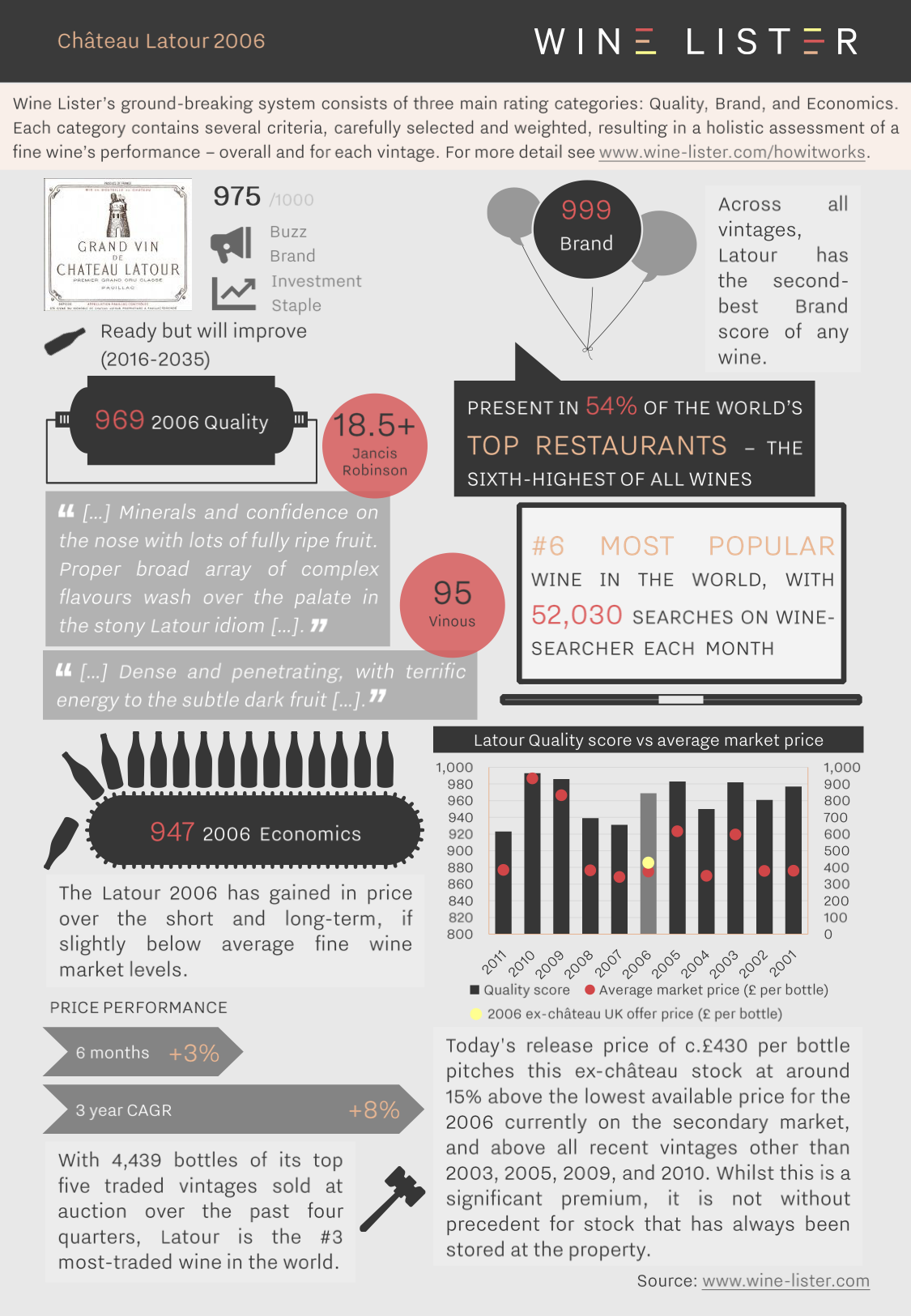
You can download this slide here: Wine Lister Factsheet Latour 2006
For wine lovers the world over, Burgundy is a region to be celebrated all year round. That being said, the modern interpretation of the traditional, post-harvest festival, La Paulée de New York, holds its West Coast counterpart this week, celebrating some of Burgundy’s finest producers in San Francisco’s best restaurants.
With Burgundy on the brain, we look back at our recent Burgundy study and the results of our Founding Members’ survey. Wine Lister asked 52 key members of the global wine trade across importers, merchants, and auction houses to rate their confidence in certain domaines from 0 to 10.
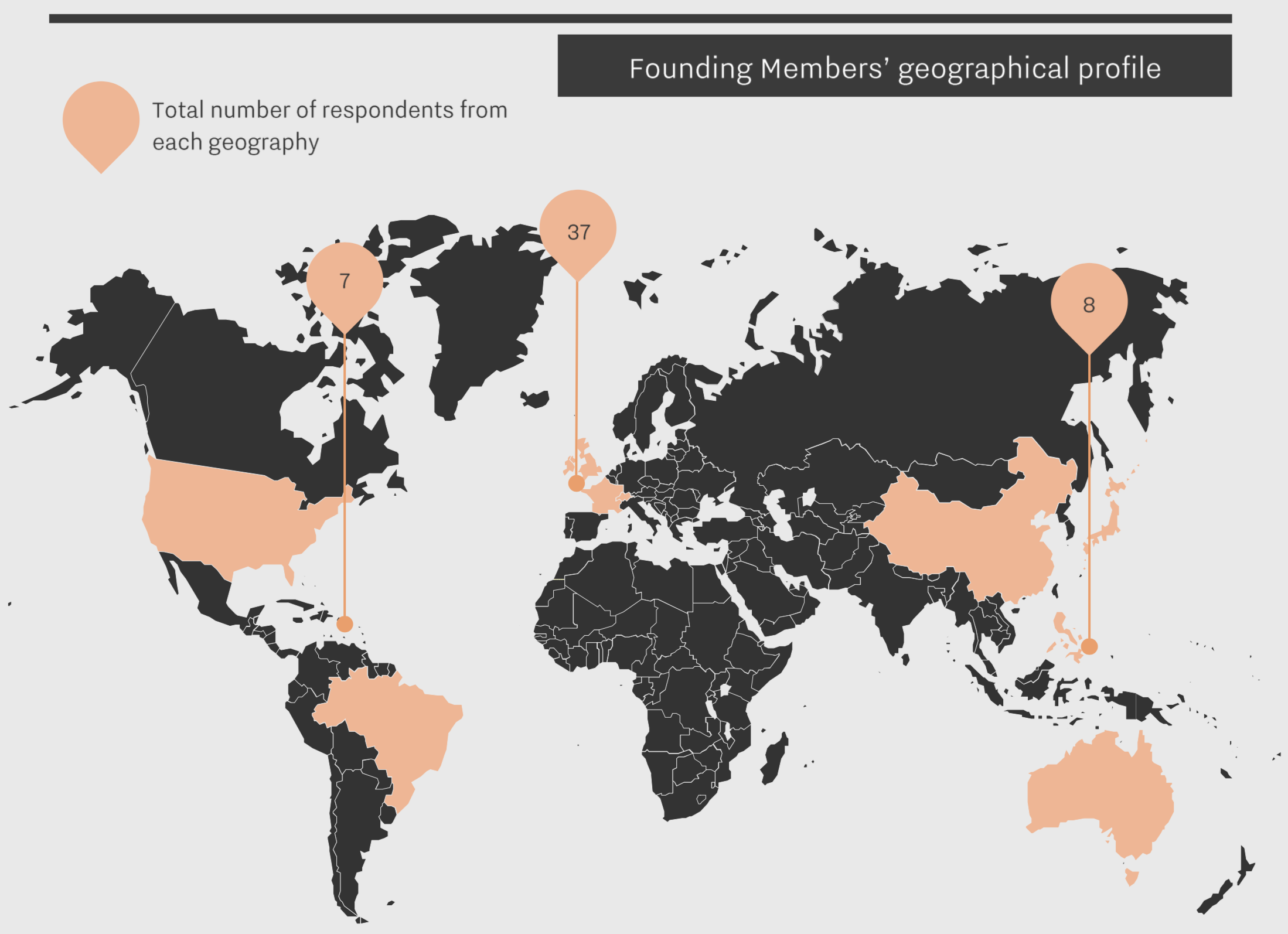
Our Burgundy study is the first to feature producers with a perfect confidence score. In Burgundy, two producers received a rating of 10/10. It perhaps comes as no surprise that Domaine de la Romanée-Conti (DRC) should be one of them. The other, Domaine Rousseau, is likely to have the strong performance of its Chambertin to thank for its perfect confidence score (Rousseau’s Chambertin holds the fifth best overall Wine Lister score in Burgundy, after four DRC wines).
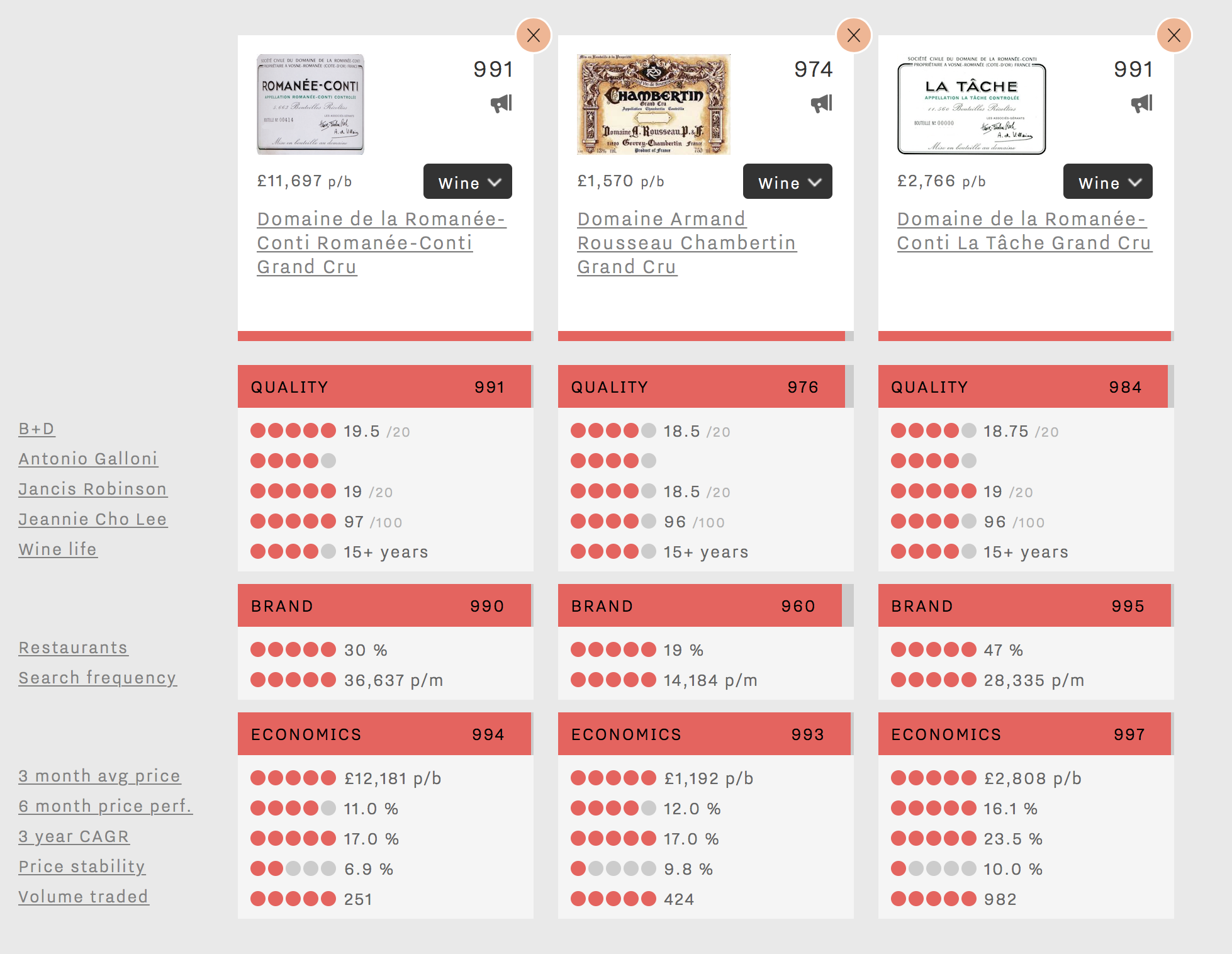
Six producers achieved a confidence rating of 9/10. D’Auvenay and Domaine Leroy’s marks confirm the trade’s outstanding level of confidence in Lalou Bize-Leroy. Whilst Mugnier and Roumier fly the flag for Burgundy’s top red producers, Coche-Dury and Raveneau show that the trade is sure about the prospects of the region’s most prestigious white wine producers.
26% of producers included in the survey gained a confidence rating of 8/10. Among them, Comtes Lafon, Ente, and Roulot confirm the prospects of Meursault and its top producers.
36% of producers received a score of 7/10 – still a strong result and underlining the trade’s high level of confidence in Burgundy. This confidence seems linked to the region’s consistent price performance, as one US fine wine auction house notes: “The single most interesting trend is pricing. Demand on the primary and secondary market is high, and it’s amazing to see that prices have not gone down at all…in years.”
For context, no Burgundy producer scored below 5/10, compared to 5% of Bordeaux wines in Wine Lister’s Bordeaux study last year.
For more detail on which Burgundy producers achieve top confidence ratings, see our full Burgundy study here, or subscribe to gain access.
For those joining the La Paulée festivities, we wish you a very happy Burgundy week!
We may have been glad to see the back of January, but it certainly wasn’t all blue. The first month of the year brought excitement to the wine world with Domaine de la Romanée-Conti’s (DRC) 2015 release, and to Wine Lister with our first ever 1000-point Brand score. For much of London’s bustling City, the end of February means one thing: bonus time. The Financial Times’ February edition of How To Spend It already features the iconic DRC – below are some further ideas for wines to blow the budget.
Prices from our data partner, Wine Owners, are shown ex duty and sales tax (VAT) per bottle as averages across Wine Lister featured vintages.
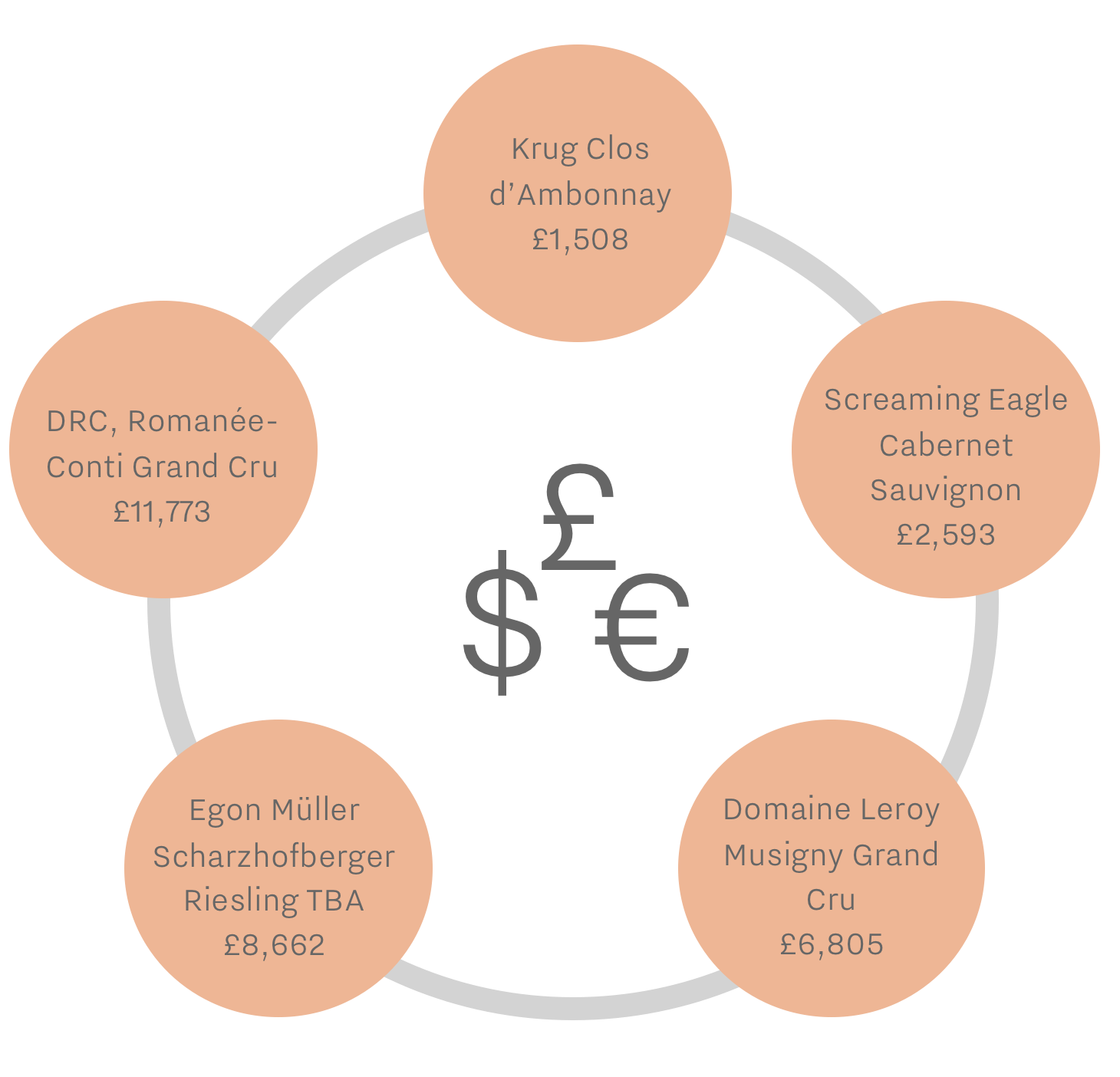
- Krug Clos d’Ambonnay
While Dom Pérignon or Louis Roederer’s Cristal are more commonly associated with City celebrations, those in the know will be toasting with Krug’s famous Pinot Noir expression. With an average Quality score of 969 and a price of £1,367 per bottle for the latest available vintage (2000), a glass of Krug Clos d’Ambonnay is, in itself, cause for celebration.
- Screaming Eagle Cabernet Sauvignon
If you’re one of the lucky few on Screaming Eagle’s direct mailing list, congratulations. It is one of the most talked-about wines by the trade based on the results of Wine Lister’s proprietary Founding Member survey, and counts over 17,000 monthly online searches on Wine-Searcher. The average £2,593 price tag per bottle is therefore a small price to pay, if indeed you are able to get your hands on one of the 7,800 bottles produced each year.
- Egon Müller Scharzhofberger Riesling TBA
Even harder to find is Egon Müller’s Scharzhofberger Riesling TBA. It breaks a number of records, including Wine Lister’s rarest wine (with an average of only 150 bottles produced per annum) and the highest ever average Wine Lister Quality score (995). Prices range from £5,848 per bottle to over £21,000 per bottle for older vintages.
- Domaine Leroy Musigny Grand Cru
The second most expensive of all French wines, let alone in Burgundy, is Domaine Leroy’s Musigny. At just over half the price of DRC Romanée-Conti, averaging £6,805 per bottle, its consistent quality is matched by impressive price growth, with a compound average growth rate of 26%. It featured in last year’s Listed blog, “the best wines money can buy”, which certainly still rings true.
The Bordeaux 2015 vintage broke a more lacklustre run since the formidable 2010, and seemed to prove the wine trade legend of vintages ending in 5. En primeur tastings took place at the crest of “Bordeaux Bashing”, with some journalists reluctant to praise the vintage too highly, and there was talk of inconsistency between appellations. Saint-Estèphe was said to have suffered from more rain than its southerly neighbours, for example. Meanwhile in Saint-Emilion, a lack of homogeneity allowed each wine to express its terroir and its identity to the utmost.
Now that the wines have been bottled, it seems a suitable time to revisit the vintage. Our CEO, Ella Lister, has just got back from tasting over 200 wines from across the two banks with Wine Lister’s partner critics Michel Bettane and Thierry Desseauve. She reports Saint-Estèphe as “exceptional and wrongly dismissed as rained-out”, and names Figeac and Canon as two highlights, both “stunning”. The two Saint-Emilion wines are among the top five Quality scores for the vintage on Wine Lister.
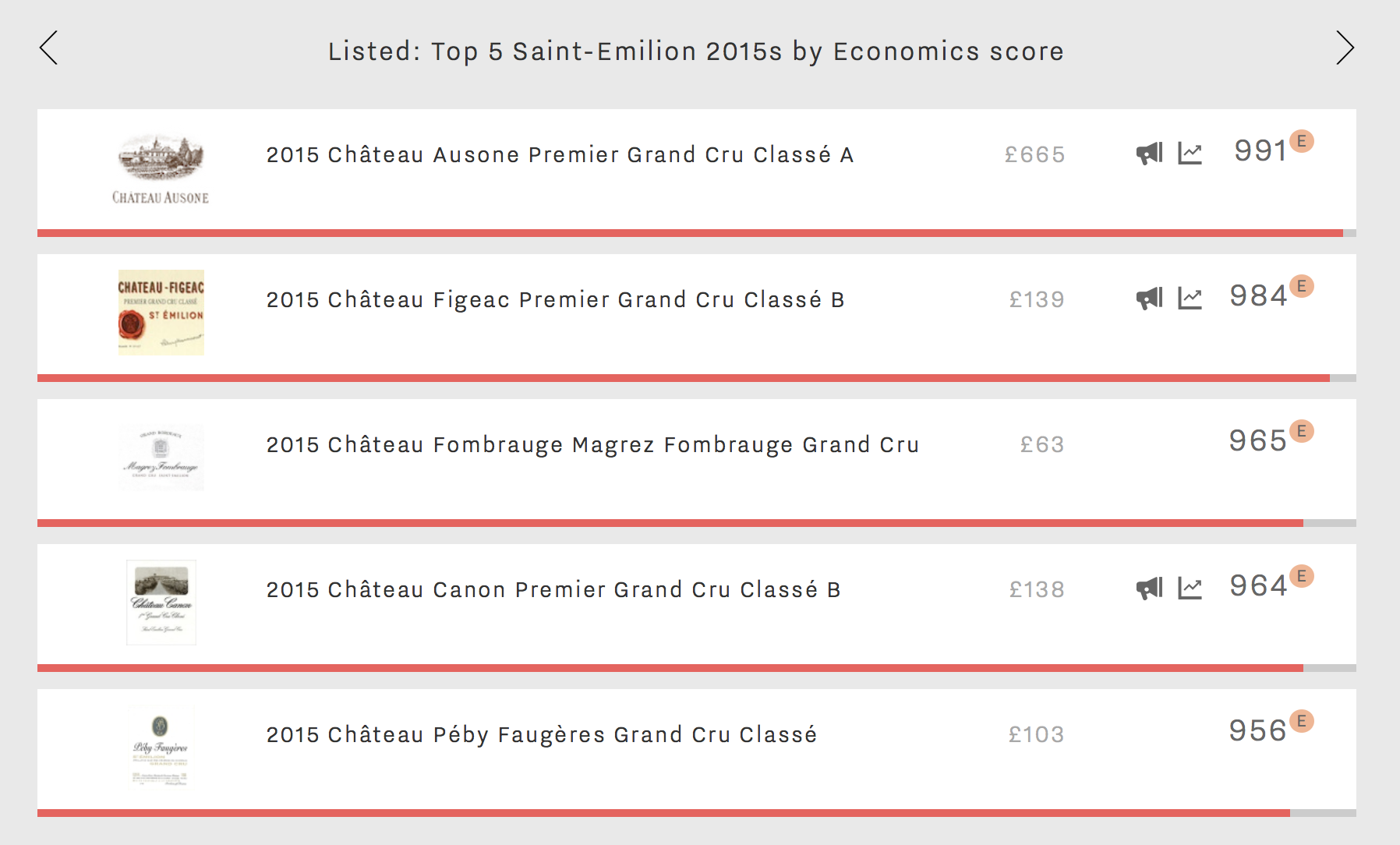
Figeac and Canon both also feature in this week’s top 5: Saint-Emilion 2015 Economics scores, showing that the market recognises their worth. Coming in second and fourth place, both hold premier grand cru classé B status since the reclassification of Saint-Emilion in 2012. Château Figeac 2015 achieves its best Economics score to date with an impressive six-month price performance of 18%.
However, Château Canon is the real surprise here. One of the most talked-about wines by the fine wine trade, its Wine Lister scores are improving from vintage to vintage, with its Economics scores, in particular, soaring. It comes in second place among all Bordeaux wines for Economics score in the 2016 vintage. Both Figeac and Canon are Buzz Brands and also Investment Staples (two of the four Wine Lister Indicators), and so is number one on the list…
Beating both of these is premier grand cru classé A, Château Ausone, with an Economics score of 991 – a record high for this producer, even against the strong 2005 vintage. The château also gains the number one spot across all Saint-Emilion 2015s in Quality, with a score of 990. In the context of overall Wine Lister scores, Ausone is just behind Petrus and Margaux as the third highest-scoring Bordeaux of 2015.
Magrez-Fombrauge and Péby Faugères are the ‘underdog’ entries among Saint-Emilion Economics performers. With Quality and Brand scores ranging from average to strong, the overall score of both wines is “strong” according to the Wine Lister 1,000-point scale (the other three entries sit comfortably in the “strongest” category, with overall scores significantly above 900).
In contrast, one might expect some bigger names, such as Cheval Blanc (a Wine Lister Buzz Brand) to appear higher up the list. Its Economics score of 946 puts it in seventh place, with slower price growth (3% over the last six months). Its price per bottle currently stands at around £500, over five times higher than that of Péby Faugères, and seven times more than Magrez-Fombrauge.
Our most recent market study is out, this time analysing 175 of Burgundy’s finest wines. Last week’s blog gave an overview of the study’s key findings. This week we take a deeper look into one of the upward trends, exploring some of Burgundy’s best price performers.
While it is impossible to argue the position of Domaine de la Romanée-Conti at the top of the Quality and Brand leaderboards, a greater mix of producers excel in long-term price performance. Lalou-Bize Leroy’s Domaine d’Auvenay is a frequent and expected feature within the top price performers, but the list is not without surprises.
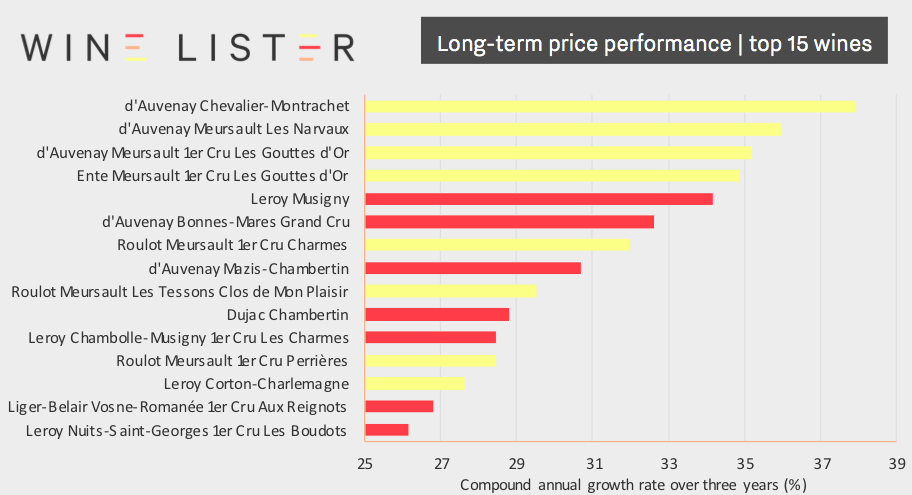
Arnaud Ente, while well known by those in the trade, is a quieter name in the global wine world. What Ente lacks in brand presence he makes up for in exceptional quality. Vines, notably his enviable Meursault plots, tend to be harvested late, giving wines their signature opulence. With a Quality score of 909 and a 3-year compound annual growth rate (CAGR) of 34%, Ente’s Meursault Les Gouttes d’Or is one of the best performing whites in Burgundy and the best 5-year price performer.
The Meursault village as a whole steals the show on price performance, accounting for 6 of the top 10 wines in the Economics score-criterion. Domaine Roulot, another producer flying slightly under the radar of Burgundy’s biggest brands also demonstrates strong long-term price performance across all three of their Meursault cuvées.
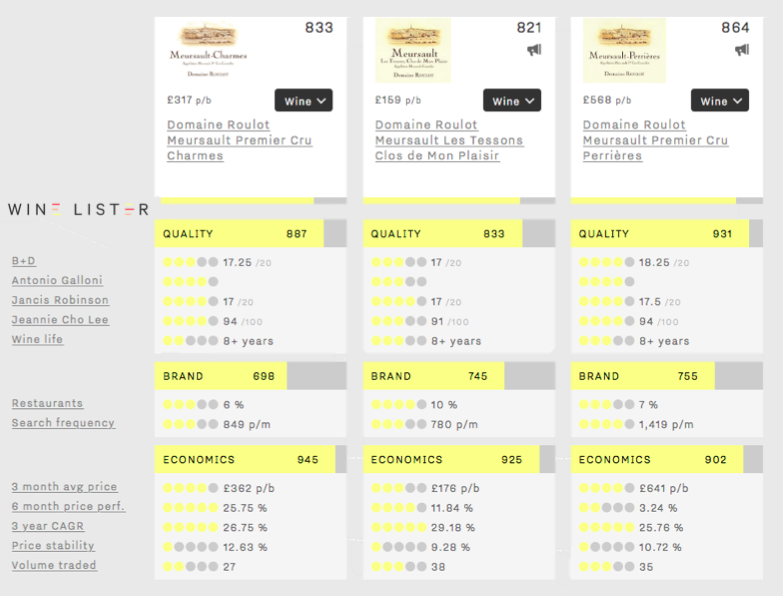
Meursault is not the only white village on the up. According to our Founding Members’ survey, which accompanies the Burgundy market study, the popularity of Saint-Aubin is increasing. Whether searching for the highest quality or the best value, it seems the white vineyards of Burgundy are the places to be this year.
You can read about more Burgundy trends in the full Burgundy market study by subscribing here. Alternatively, a preview of the first 15 pages is available here.
Brands such as Sassicaia or Masseto are virtually household names. Known to most as ‘Super Tuscans’, the unofficial ‘Crus Classés’ of Tuscany’s IGT-elite have garnered a reputation for high quality and investment calibre over the last 20 years, and have a price tag to match.
Most would agree that the first Super Tuscan was Sassicaia, produced by Mario Incisa della Rocchetta, who planted Cabernet Sauvignon for his family’s own personal stock, before releasing it commercially from 1968.
The early Super Tuscan sought to by-pass the DOC system and rules banning international varieties. Labelled simply as ‘vino da tavola’, consumers were able to decide for themselves on the quality of the liquid in the bottle. Meanwhile, Sassicaia earnt its own DOCG in 2013, and has the strongest brand in Italy and one of the strongest in the world – but what of the rest?
Last month Wine Lister explored Italy’s top wines for Economics, and found that the economic profiles of Piedmont’s top wines (Barolo and Barbaresco), beat their Tuscan counterparts. So what can consumers expect from Tuscany, apart from an idyllic holiday destination?
The Tuscan crown for Brand scores still firmly sits on the heads of the big five (Sassicaia, Tignanello, Ornellaia, Masseto, and Solaia), but with a little more digging, exceptional quality can certainly be found beyond these few names. Indeed, eight of Wine Lister’s top 10 Italian Value Picks by Quality score come from the country’s central region:
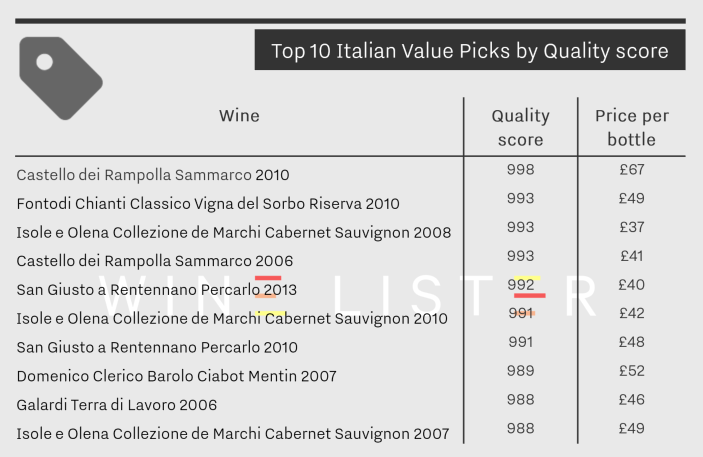
Value Picks are defined as wines with the best quality-to-price ratio, with an emphasis on quality. Of the Tuscan entries, only one is a DOCG – the Chianti Classico Vigna del Sorbo Riserva 2010 from Fontodi. The others are IGT, or ‘Super Tuscan’, such as Castello dei Rampolla Sammarco 2006 and 2010, and San Giusto a Rentannano Percarlo 2010 and 2013.
On average, Super Tuscan Value Picks cost £26 per bottle, and achieve Quality scores of 864. Meanwhile Super Tuscan Buzz Brands cost six times as much for the for an average Quality score of 889.
Whether Tuscany’s classification system will be able to define a true quality hierarchy in time is not clear. In the meantime, Wine Lister’s scoring system sheds some light on where the real value of Tuscany lies.
Also featured: Isole e Olena Collezione de Marchi Cabernet Sauvignon; Domenico Clerico Barolo Ciabot Mentin; Galardi Terra di Lavoro







